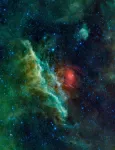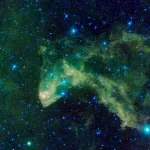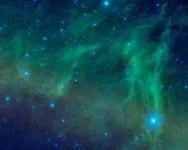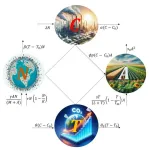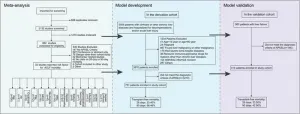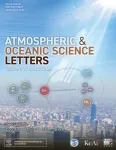(Press-News.org) While NASA’s NEOWISE telescope ended its journey through space on Nov. 1, 2024, the team at IPAC, a science center at Caltech, was working on one further gift from the prolific mission.
The final data release from NEOWISE was released to the astronomy community just two weeks later, on Nov. 14, encompassing over 26 million images and nearly 200 billion sources detected by the telescope. And today, IPAC is releasing six new images from the mission’s archival data as a tribute to this landmark project, available here: https://www.astropix.org/link/3b2x
NEOWISE was launched as the Wide-field Infrared Survey Explorer (WISE) in 2009 and then reactivated in 2013 as NEOWISE, the asteroid-hunting phase of the mission. The infrared space telescope studied the entire night sky and conducted 21 complete sky surveys during more than a decade of operation. The mission focused on identifying and studying small objects in our solar system like asteroids and comets, also known as near-Earth objects (NEOs), but the infrared data collected by the telescope has proven to have countless applications throughout the field of astronomy.
The mission concluded operations in July 2024, and during its 15 years in space, scientists have been able to revisit the same areas of the sky again and again, with most being observed by NEOWISE at least 220 times. This repeated observation helps astronomers search for and study objects that change in brightness or location.
“Being able to watch the changing sky for nearly 15 years has opened a new avenue for time-domain science, for everything from the closest asteroids to the most distant quasars,” said Joe Masiero, Research Scientist at IPAC and the Deputy Principal Investigator of the mission.
In recent years, NEOWISE has enabled scientists to study curious objects like brown dwarfs and discover patterns in large populations of comets. Over its mission lifetime, NEOWISE has characterized over 3000 NEOs—approximately 10% of the known population, and something that was only possible due to its long tenure scanning the sky.
The final NEO observed by NEOWISE, known as 2007 LV8, was seen over 100 times in the closing days of the survey since it closely followed the telescope’s scan pattern.
“Because of NEOWISE’s extensive view of the sky, we get a more complete picture of the asteroids and comets in Earth’s orbital neighborhood. The data provide a unique way of understanding factors like the size and rotation period of these NEOs,” said Roc Cutri, NEOWISE Task Lead and Project Scientist at IPAC.
The team at IPAC was responsible for the ingestion and processing of raw data, production of final data products, and archiving mission science and engineering data. IPAC also distributes WISE/NEOWISE data to the community through the NASA/IPAC Infrared Science Archive (IRSA) and provides services such as powerful analysis and visualization tools. The IPAC Communications & Education team prepares mission images for public release in the AstroPix image gallery.
Never-before-seen images from NEOWISE
During the original WISE mission, over 100 areas of the sky were highlighted in public image releases, but they revealed only a tiny fraction of the full-sky coverage of the survey.
“The WISE and NEOWISE data releases are built for researchers, but they also embody some of the most amazing images of our infrared sky,” said Robert Hurt, IPAC Visualization Scientist. “They are so easy to work with it's almost too easy to make a beautiful image from them! That's why I wanted to revisit the archive to locate some hidden gems we missed before.”
To find new interesting areas of the sky, the positions of the previous images were overlaid onto maps of the sky using data from WISE and other missions. The new map revealed many zones that have not been highlighted for the public but contain fascinating regions of cosmic dust where stars are born. Six spots were selected, with many of them spanning large areas of the sky—a distinct advantage of an all-sky survey such as NEOWISE.
One image stands out as particularly meaningful to the IPAC community: NEOWISE’s view of the California Nebula.
Named after the dust cloud’s resemblance to the California coastline, Masiero says it commemorates the years of hard work and dedication of the NEOWISE data processing team at IPAC, located in Pasadena, California.
“I’m really grateful for all of the people at IPAC who have put so much effort into making this the best dataset possible, for today and for future generations,” said Masiero.
The California Nebula is located in the Milky Way, about 1000 light-years away, in the Perseus constellation. It is a dusty region illuminated by the nearby massive star Menkib, born just a few million years ago. The entire California Nebula stretches across 100 light-years and is fully captured in this wide-field view. The dust clouds glow brightly in longer wavelengths of infrared light, displayed here in green and red.
The new images pulled from the archives represent the billions of sources detected by NEOWISE waiting to be studied by future researchers.
“We know there are more things to discover in the NEOWISE data that we just haven’t noticed yet,” said Masiero. “As astronomers develop new tools and techniques and as new surveys are conducted, we can be sure the NEOWISE archive will be one of the first places we look for the data needed to better understand our universe.”
NEOWISE’s legacy is only just beginning
As astronomers continue to mine the NEOWISE archive at IRSA, there are many untold stories of comets, asteroids, nebulae, and more waiting in the data.
Yuna Kwon, a solar system astronomer and IPAC archive scientist, first joined as a postdoctoral fellow in 2023. Even though the NEOWISE mission ended not long after, her work with its data is only just beginning.
Along with Masiero, Kwon is leading a project called COSINE, Cometary Object Study Investigating their Nature and Evolution, cataloging and analyzing comets observed by NEOWISE.
“Together with my amazing colleagues at IPAC, we now have the largest-ever consistently analyzed comet database and are preparing publications based on our findings,” said Kwon.
Kwon studies comets because they are some of the oldest and most primitive objects in our solar system. Their physical properties could tell us about the conditions during the solar system’s formation.
“Comets are like cats — they have tails and do precisely what they want,” said Kwon. “Thankfully, NEOWISE has a treasure trove of data to study these idiosyncratic objects.”
Before working with NEOWISE data, Kwon said that it was hard to decipher large-scale trends from only a small number of comets. But now with COSINE and NEOWISE data, she is able to understand the big picture.
“I'm truly enjoying this exploration,” said Kwon. “My experience with NEOWISE data has broadened my perspective and deepened my understanding of the comet population itself, putting the observations in a broader context of the formation and evolution of the solar system.”
Going forward, Kwon hopes to combine the knowledge gained from NEOWISE with new data from upcoming observatories including NEO Surveyor and SPHEREx.
###
IPAC’s Roles in the NEOWISE Mission:
* Receiving and ingesting raw data from the telescope into IPAC’s science data system
* Processing images and calculating the accurate positions and brightness of all objects detected within them
* Creating a catalog of all NEOWISE images, searchable by position or object
* Testing and verifying the scientific fidelity of calculated parameters
* Leading scientific investigations using NEOWISE data
* Identifying moving object candidates and quickly reporting them to the IAU Minor Planet Center so scientists across the world can follow-up on objects of interest
* Curating the mission data products and providing easy-to-use data access and analysis tools for the community via the NASA/IPAC Infrared Science Archive (IRSA)
* Producing and maintaining the Explanatory Supplement to the NEOWISE Data Release Products
* Answering community questions and making sure the scientific return from the mission is maximized
* Representing NEOWISE to the scientific community at conferences and workshops
* Mission public release images were prepared by the IPAC Communications and Education (ICE) team and NASA
#
More About the Mission:
IPAC at Caltech is a science and data center for astrophysics and planetary sciences. Science data processing, archiving, and distribution for WISE and NEOWISE was done at IPAC. The NASA/IPAC Infrared Science Archive (IRSA) is responsible for the archiving and distribution of WISE and NEOWISE data for the astronomical community.
NEOWISE supported the objectives of NASA’s Planetary Defense Coordination Office (PDCO) at NASA Headquarters in Washington. JPL managed and operated the NEOWISE mission for PDCO within the Science Mission Directorate. The WISE principal investigator was Edward Wright, a professor at UCLA. The NEOWISE principal investigator was Amy Mainzer, also a professor at UCLA. The Space Dynamics Laboratory in Logan, Utah, built the science instrument. Ball Aerospace & Technologies Corp. of Boulder, Colorado (now BAE Systems), built the spacecraft. Caltech manages JPL for NASA.
###
END
Final data and undiscovered images from NASA’s NEOWISE
2024-11-26
ELSE PRESS RELEASES FROM THIS DATE:
Nucleoporin93: A silent protector in vascular health
2024-11-26
"Research in the last several decades has established endothelial cells (ECs) as a dynamic interface critical for vascular protection.”
BUFFALO, NY- November 26, 2024 – This editorial was published by Aging (listed by MEDLINE/PubMed as "Aging (Albany NY)" and "Aging-US" by Web of Science) in Volume 16, Issue 17, titled, “The silent protector: Nucleoporin93’s role in vascular health.”
Written by Julia Michalkiewicz, Tung D. Nguyen, and Monica Y. Lee from The University of Illinois at Chicago College of Medicine, ...
Can we avert the looming food crisis of climate change?
2024-11-26
WASHINGTON, Nov. 26, 2024 – Human activities are causing atmospheric carbon dioxide (CO2) levels to rise, which increases the global average surface temperature—and poses a threat to crop growth. Escalating concerns about climate change’s impact on global food security inspired researchers from Banaras Hindu University in India to create a way to explore how these factors influence crop yields.
In Chaos, from AIP Publishing, the researchers share a mathematical model created to capture the nonlinear relationships between CO2, temperature, human population, ...
Alcohol use and antiobesity medication treatment
2024-11-26
About The Study: This cohort study among individuals participating in a weight loss program found that nearly half of those consuming alcohol at baseline decreased their alcohol use after anti-obesity medication initiation. There may be properties of anti-obesity medications that lead to reduced use. For example, naltrexone decreases cravings for alcohol and glucagon-like peptide-1 receptor agonists (GLP-1 RAs) may attenuate the rewarding effects of alcohol, similar to food.
Corresponding Author: To contact the corresponding author, Lisa R. Miller-Matero, PhD, email lmatero1@hfhs.org.
To access the embargoed study: Visit our For The Media website at ...
Study reveals cause of common cancer immunotherapy side effect
2024-11-26
A multinational collaboration co-led by the Garvan Institute of Medical Research has uncovered a potential explanation for why some cancer patients receiving a type of immunotherapy called checkpoint inhibitors experience increased susceptibility to common infections.
The findings, published in the journal Immunity, provide new insights into immune responses and reveal a potential approach to preventing the common cancer therapy side effect.
“Immune checkpoint inhibitor therapies have revolutionised cancer treatment ...
New era in amphibian biology
2024-11-26
Amphibians hold a significant place in evolution, representing the transition from aquatic to terrestrial lifestyles. They are crucial for understanding the brain and spinal cord of tetrapods—animals with four limbs, including humans. A group of scientists led by a team at the Institute of Science and Technology Austria (ISTA) now shows how harmless viruses can be used to illuminate the development of the frog nervous system. The results have now been published in Developmental Cell.
Virus. When you hear the word, you probably shudder. But not all viruses are bad or cause disease. Some are even used for therapeutic ...
Harbor service, VAST Data provide boost for NCSA systems
2024-11-26
The National Center for Supercomputing Applications and VAST Data are giving supercomputing system Delta and the newly launched DeltaAI a boost in their storage and application performance.
NCSA launched Harbor, a service that provides very fast storage for global home and software directories across all NCSA open-science resources. Its deployment has led to a 400% increase in application launch performance for the Delta system, among many other gains.
Over the last two years, we’ve seen a significant increase in ...
New prognostic model enhances survival prediction in liver failure
2024-11-26
Researchers have unveiled a groundbreaking advancement in liver failure care: the CATCH-LIFE-MELD score (Chinese Acute-on-Chronic Liver Failure Consortium (CATCH-LIFE)-MELD score). This innovative tool, developed by an international team led by Xia Yu and colleagues, enhances the accuracy of predicting short-term survival outcomes for patients suffering from acute-on-chronic liver failure (ACLF). The study, published in eGastroenterology, promises to revolutionize patient management and treatment planning for this life-threatening condition.
“ACLF presents unique challenges due to its rapid progression and high mortality rates,” said Dr. Yu Shi, senior researcher at Zhejiang University ...
China focuses on improving air quality via the coordinated control of fine particles and ozone
2024-11-26
A recent special issue of the journal Atmospheric and Oceanic Science Letters has brought together some of China's top scientists to provide a picture of the latest progress in understanding and controlling air pollution.
Fine particulate matter, referred to as PM2.5, and ground-level ozone (O3) are the main pollutants degrading the air quality of China’s cities and wider urban regions. Both have serious human health effects, such as heart disease, asthma, and lung damage.
The World Health Organization (WHO) provides clear guidelines regarding acceptable concentrations ...
Machine learning reveals behaviors linked with early Alzheimer’s, points to new treatments
2024-11-26
SAN FRANCISCO—November 26, 2024—Subtle signs of Alzheimer’s disease can emerge decades before a diagnosis—often in the form of irregular behaviors that reflect very early stages of brain dysfunction.
But until now, identifying and measuring these slight behavioral changes in a scientific way hasn’t been feasible, not even when studying Alzheimer’s in mice.
In a study published in Cell Reports, a team of scientists at Gladstone Institutes used a new video-based machine learning tool to pinpoint ...
Novel gene therapy trial for sickle cell disease launches
2024-11-26
UCSF Benioff Children's Hospital Oakland is enrolling patients in an innovative clinical trial that seeks to cure sickle cell disease. The trial is the first in the U.S. to apply non-viral CRISPR-Cas9 gene-editing technology in humans to directly correct the genetic mutation that causes the disease.
The research involves taking the patient’s blood stem cells to correct the mutation and returning those edited cells to the patient through a bone marrow transplant. It’s hoped the corrected blood stem cells will then multiply and create a new blood system, one free of sickle cell.
“This ...
